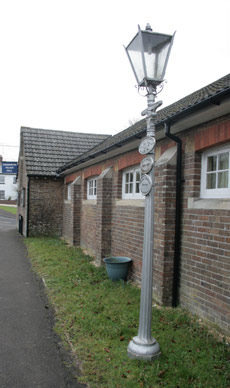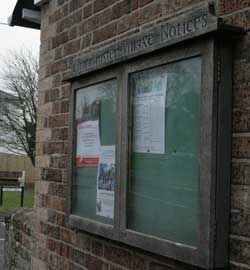The origins of Charminster Village Hall
Ours is one of the oldest halls in the county, dating from 1877. It was the driving force of Mr. Albert Bankes of Wolfeton House that raised the necessary money, by public subscription, to build the first part of the hall, facing on to West Hill. It was to be a Working Men's Institute, an alternative to drinking in the alehouses.

Its entrance on West Hill, which we have tried to preserve as close as possible to its original state, led into two rooms, each with its fireplace. One was a Smoking Room, the other a Reading Room. When it was gutted for the recent renovation, I tried to see any sign of which end was which - but it was impossible to tell, both walls were brown from a century of tobacco smoke. It had no toilet or other facilities, of course, just a men's lean-to in the field at the side.
However, it was not long before it began to take on the role of village hall. The local newspaper reported entertainments and even cookery demonstrations, so it had stopped being for male use only. And soon it was not big enough - demand for a larger space led to the addition, in 1905, of the main hall. Still no kitchen or toilets just the men's lean-to outside.
Once again it was funded by generous public subscription. Indeed, the generosity went further. The hall and the land it stands on, which belonged to Captain Adolphus Meyer of Charminster House, were gifted to the village, with the Salisbury Diocesan Board of Management holding the title deeds, to be used for the benefit of all inhabitants. It was to be run by a committee of local notables, under the chairmanship of the Vicar, who was to have sole use of the Hall on Sundays, while the other managers had it on the other days of the week.

By the 1960s it had got into what one parish councillor described as a 'disgraceful state'. It was running at a significant loss. It needed capital for major repairs and changes. The Diocesan Board of Finance wanted to be rid of the responsibility. The Parish Council was not prepared to take it on. There was a very real danger that would die. Fortunately the committee that was formed to sec what could be done came up with a solution.
Funding was found from individual donations and some grants to pay for essential repairs and modifications. There was a kitchen and a ladies toilet. The men at last did not have to go and stand in the field. And, most importantly, we became a Charity by order of the Charity Commissioners, with the stated object for the Hall of being held in trust for the use of the inhabitants of Charminster and neighbourhood, 'without distinction of sex or political, religious or other opinions'. That is still the object of the Trust today.
Various ad hoc changes to the interior followed over the years. By 2003, however, it was clear we had to take another hard look at the Hall's future viability. The facilities (kitchen. toilets) were frankly poor and we were being shown up badly by the new or improved halls in nearby villages (Stratton, Frampton and Charlton Down). There were signs we were starting to lose bookings. We faced a future of probable decline which if left unchecked, would eventually make the Hall unable to pay its way unless we could renovate it.
Once again, as in the funding of the original construction, Charminster came up trumps. Over the past five years we have received no less than £30,000 in donations (including gift aid), another £15,000 from fund raising activities, and over £50,000 in grants. In other words, the people of Charminster provided almost as much as the outside grant sources. The generosity of so many people has been of the highest order, and we trustees owe a great debt of gratitude to the people of Charminster for their wonderful support.
The complete renovation of the I877 part of the building was completed in November 2006 and has received widespread approval. Further work in the main hall continues.
Maintenance of this historic building is an ongoing task. The hall's committee organises a number of fund-raising events each year, and we're grateful for the continued support of the village community.
Nigel Kay, November 2024.
